-
Countries
-
Data and Analysis
-
Special Focus
-
Crisis Responses
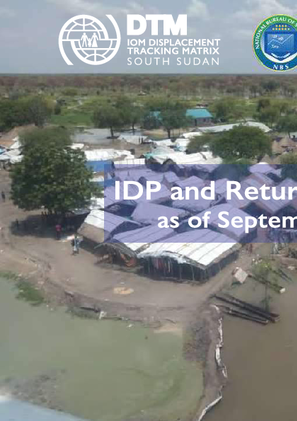
Contact
DTM South Sudan, SouthSudanDTM@iom.int
Language
English
Location
South Sudan
Period Covered
Jul 01 2021
Sep 30 2021
Activity
- Mobility Tracking
- Baseline Assessment
This atlas contains a summary of findings from the eleventh round of Mobility Tracking conducted across South Sudan through key-informant based assessment at payam and location level between July and September 2021. Mobility Tracking quantifies the presence of internally displaced persons (IDPs) and returnees in South Sudan in displacement sites and host communities. IOM DTM mapped a total of 2,017,236 IDPs (that includes 7% previously displaced abroad) and 1,782,803 returnees (that includes 34% from abroad) in 3,335 locations across South Sudan as of September 2021.
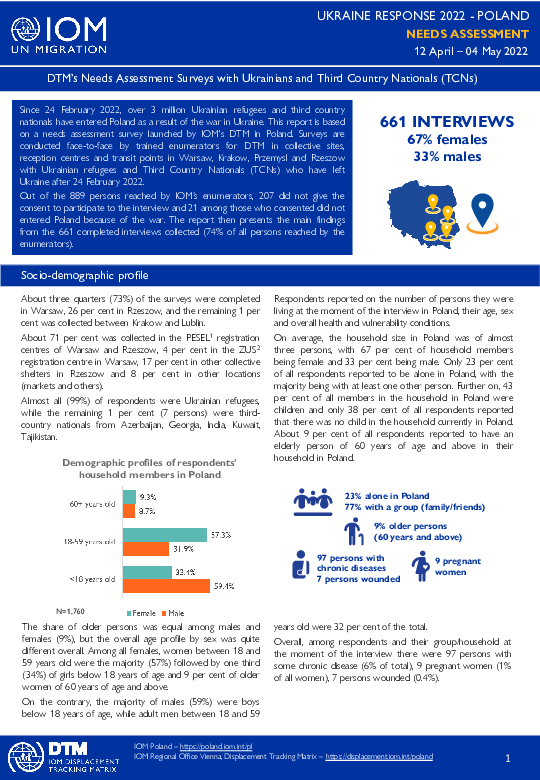
Contact
DTM Europe, DTMMediterranean@iom.int
Language
English
Location
Poland
Period Covered
Apr 12 2022
May 04 2022
Activity
- Survey
- Community Perception
Since 24 February 2022, over 3 million Ukrainian refugees and third country nationals have entered Poland as a result of the war in Ukraine. This report is based on a needs assessment survey launched by IOM's DTM in Poland. Surveys are conducted face-to-face by trained enumerators for DTM in collective sites, reception centres and transit points in Warsaw, Krakow, Przemysl and Rzeszow with Ukrainian refugees and Third Country Nationals (TCNs) who have left Ukraine after 24 February 2022. Out of the 889 persons reached by IOM’s enumerators, 207 did not give the consent to participate to the interview and 21 among those who consented did not entered Poland because of the war. The report then presents the main findings from the 661 completed interviews collected (74% of all persons reached by the enumerators).
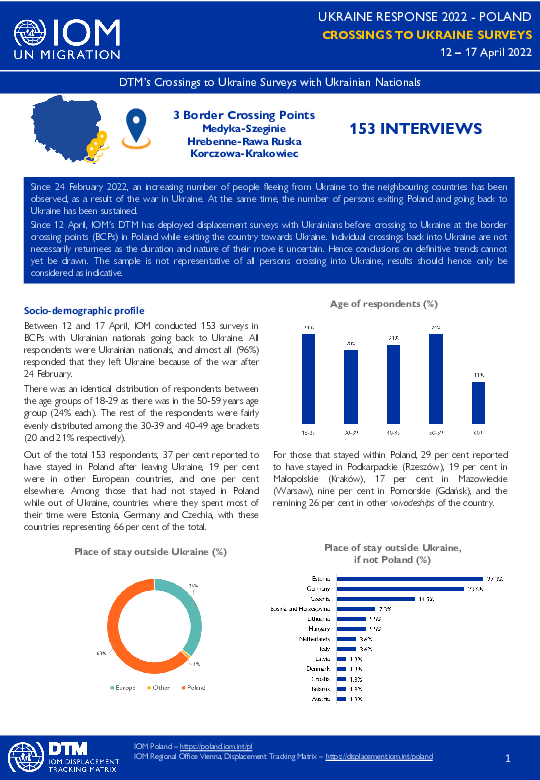
Contact
DTM Europe, DTMMediterranean@iom.int
Language
English
Location
Poland
Period Covered
Apr 12 2022
Apr 17 2022
Activity
- Survey
Since 24 February 2022, an increasing number of people fleeing from Ukraine to the neighbouring countries has been observed, as a result of the war in Ukraine. At the same time, the number of persons exiting Poland and going back to Ukraine has been sustained.
Between 12 and 17 April, IOM conducted 153 surveys in 3 Border Crossing Points (Medyka-Szeginie, Hrebenne-Rawa Ruska and Korczowa-Krakowiec) with Ukrainian nationals going back to Ukraine.

Contact
DTMMozambique@iom.int
Language
English
Location
Mozambique
Period Covered
May 25 2022
May 31 2022
Activity
- Mobility Tracking
- Event Tracking
During the reporting period (25 to 31 May 2022), a total of 128 movements were recorded - 68 arrivals (4,017 individuals), 30 returns (2,230 individuals), 26 departures (614 individuals), and 4 transits (299 individuals). The largest arrival movements were recorded in Macomia (3,089 individuals), Quissanga (278 individuals), Muidumbe (153 individuals) and Meluco (121 individuals). The largest return movements were recorded in Palma (1,587 individuals), Muidumbe (287 individuals), Quissanga (184 individuals) and intended return movements originating from Montepuez (161 individuals). The largest departure movement were observed in Nangade (435 individuals) and Mueda (101 individuals). Of the total population, 25 per cent of mobile groups were displaced for the first time, and 75 per cent of reported individuals have been displaced more than once prior to this movement.
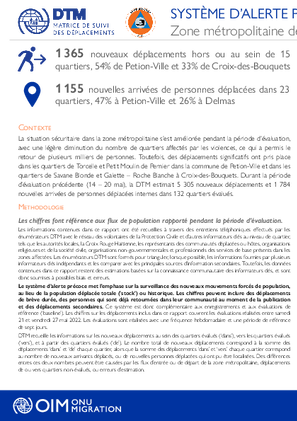
Contact
dtmhaiti@iom.int
Language
French
Location
Haiti
Period Covered
May 21 2022
May 27 2022
Activity
- Mobility Tracking
- Event Tracking
La situation sécuritaire dans la zone métropolitaine s'est améliorée pendant la période d'évaluation, avec une légère diminution du nombre de quartiers affectés par les violences, ce qui a permis le retour de plusieurs milliers de personnes. Toutefois, des déplacements significatifs ont pris place dans les quartiers de Torcelle et Petit Moulin de Pernier dans la commune de Petion-Ville et dans les quartiers de Savane Blonde et Galette – Roche Blanche à Croix-des-Bouquets. Durant la période d’évaluation précédente (14 – 20 mai), la DTM estimait 5 305 nouveaux déplacements et 1 784 nouvelles arrivées de personnes déplacées internes dans 132 quartiers évalués.
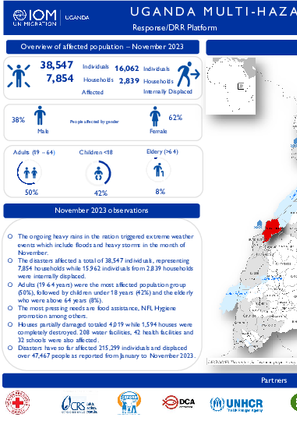
Contact
DTM Yemen, iomyemendtm@iom.int
Language
English
Location
Yemen
Period Covered
May 29 2022
Jun 04 2022
Activity
- Mobility Tracking
IOM Yemen DTM’s Rapid Displacement Tracking (RDT) tool collects data on estimated numbers of households forced to flee on a daily basis from their locations of origin or displacement, allowing for regular reporting of new displacements in terms of estimated numbers, geography, and needs. It also tracks returnees who returned to their location of origin.
From 1 January to 4 June 2022, IOM Yemen DTM tracked 6,328 households (HH) (37,968 Individuals) who experienced displacement at least once.
Between 29 May and 4 June 2022, IOM Yemen DTM tracked 113 households (678 individuals) displaced at least once. The majority of people moved into/within the following governorates and districts:
- Ad Dali (36 HHs) – Qatabah (28 HHs), Ad Dali (5 HHs), Al Hasayn (3 HHs) districts. Most displacements in the governorate originated from Ad Dali and Ibb.
- Al Hodeidah (22 HHs) – Al Khukhah (15 HHs), Hays (7 HHs) districts. Most displacements in the governorate originated from Taiz and Al Hodeidah.
- Marib (19 HHs) – Marib City (12 HHs), Marib (7 HHs) districts. Most displacements in the governorate originated from Marib and Sanaa.
The majority of people moved from the following governorates and districts:
- Taiz (26 HHs) – Maqbanah (16 HHs), Al Makha (4 HHs), Ash Shamayatayn (3 HHs) districts.
- Al Hodeidah (23 HHs) – Hays (5 HHs), Ad Durayhimi (4 HHs), Bayt Al Faqih (3 HHs) districts.
- Ibb (15 HHs) – Ar Radmah (5 HHs), Badan (5 HHs), Al Qafr (2 HHs) districts.
Contact
DTM Yemen, iomyemendtm@iom.int
Location
Yemen
Activity
- Mobility Tracking
- Event Tracking
Period Covered
May 29 2022 -Jun 04 2022
From 1 January to 4 June 2022, IOM Yemen DTM tracked 6,328 households (HH) (37,968 Individuals) who experienced displacement at least once.
Between 29 May and 4 June 2022, IOM Yemen DTM tracked 113 households (678 individuals) displaced at least once. The majority of people moved into/within the following governorates and districts:
Between 29 May and 4 June 2022, IOM Yemen DTM tracked 113 households (678 individuals) displaced at least once. The majority of people moved into/within the following governorates and districts:
- Ad Dali (36 HHs) – Qatabah (28 HHs), Ad Dali (5 HHs), Al Hasayn (3 HHs) districts. Most displacements in the governorate originated from Ad Dali and Ibb.
- Al Hodeidah (22 HHs) – Al Khukhah (15 HHs), Hays (7 HHs) districts. Most displacements in the governorate originated from Taiz and Al Hodeidah.
- Marib (19 HHs) – Marib City (12 HHs), Marib (7 HHs) districts. Most displacements in the governorate originated from Marib and Sanaa.
- Taiz (26 HHs) – Maqbanah (16 HHs), Al Makha (4 HHs), Ash Shamayatayn (3 HHs) districts.
- Al Hodeidah (23 HHs) – Hays (5 HHs), Ad Durayhimi (4 HHs), Bayt Al Faqih (3 HHs) districts.
- Ibb (15 HHs) – Ar Radmah (5 HHs), Badan (5 HHs), Al Qafr (2 HHs) districts.
Population Groups
Survey Methodology
Unit of Analysis Or Observation
Type of Survey or Assessment
Keywords
Geographical Scope
Administrative boundaries with available data
The current dataset covers the following administrative boundaries
Contact
DTMUkraine@iom.int
Location
Ukraine
Activity
- Mobility Tracking
- Baseline Assessment
Period Covered
May 16 2022 -May 31 2022
A baseline assessment is a sub-component of mobility tracking. It aims to collect data on IDP, migrant or returnee population presence in a defined administrative area of the country.
This is a restricted dataset. To get access, kindly click on the 'Request Access' button.
Population Groups
IDPs
Survey Methodology
Unit of Analysis Or Observation
Admin Area 2
Site or Location
Type of Survey or Assessment
Key Informant
Keywords
Geographical Scope Partial Coverage
Administrative boundaries with available data
The current dataset covers the following administrative boundaries

Contact
dtmremapsupport@iom.int
Language
English
Location
Pakistan
Period Covered
Mar 10 2020
Apr 30 2022
Activity
- Flow Monitoring Survey
The outbreak of COVID-19 has affected global mobility through various travel disruptions and restrictions. To better understand how the pandemic affects global mobility, the International Organization for Migration (IOM) has developed an online tool and database to register points of entry (POE), exit and transit, where mobility restrictions and response measures are in place. To support these efforts, the Displacement Tracking Matrix Regional Evidence for Migration Analysis and Policy (DTM REMAP) team in Pakistan mapped and gathered data on the current statuses of POEs in the country.
Between March and April 2022, the DTM REMAP team in Pakistan monitored 17¹ POEs. These included nine airports, six land borders and two blue borders. The status of various POEs remained fully operational as most of the COVID restrictions were relaxed after a steady decrease in COVID-19 cases in the country. At the end of April, fifteen POEs were fully operational, one was partially operational and one was fully closed.
During March 2022, COVID-19 cases in the country constantly declined and, by the end of the month, 70 per cent of the population was vaccinated. Therefore, on 16 March 2022 the National Command and Operation Center (NCOC) decided to lift all COVID-19 restrictions, except for non-vaccinated people. Based on very low positivity rate of COVID-19 (0.82%) on 31 March 2022, the government decided to disband the NCOC in the country.
